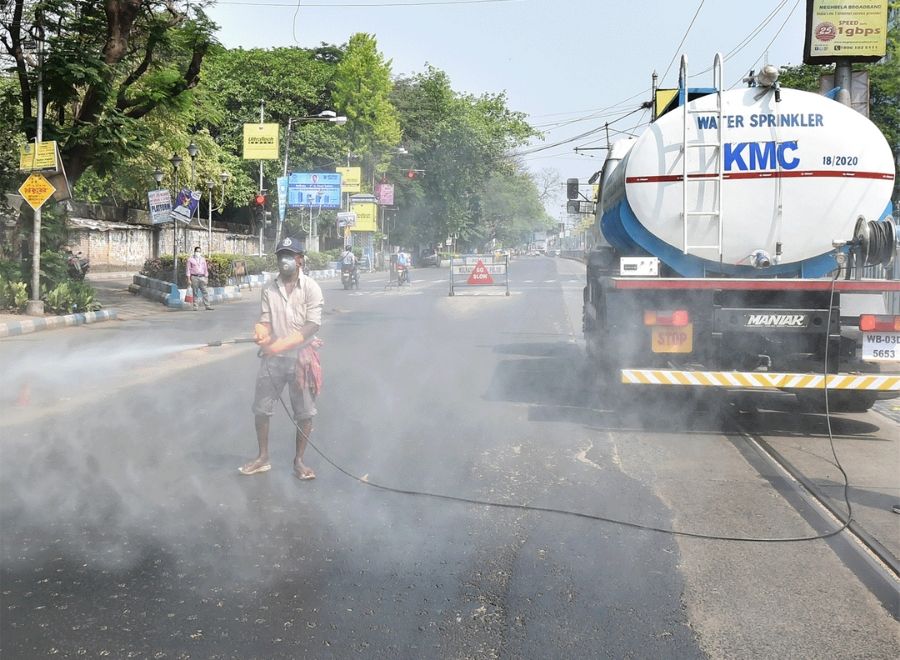
COVID disinfection deepens West Bengal's looming water crisis

The disinfection spree among people in West Bengal, following the outbreak of COVID-19, has spiked the domestic water usage in the capital Kolkata and other districts in the state, a recent survey has found. It has indicated that the looming water crisis could further deepen.
After the COVID-19 outbreak, the demand for water in Kolkata increased to almost 13.5 million litres, which is more than double the usage of 6.7 million litres before the virus struck the city, according to a survey by the Jadavpur University. The institution ranked fifth in the list of top universities of the country released by the Union Human Resource Development Ministry on Thursday (June 11).
The water consumption is equally high in three other surveyed districts—North and Sough 24 Parganas and Hooghly—pointing at a general trend, which should ring alarm bells as the state’s 174 out of 341 blocks had registered the depletion of groundwater table at the rate of more than 20 cm a year.
Related News: WB breaches 10k-mark with highest one-day spike of 476 COVID-19 cases
In North 24 Parganas district, the water usage had increased to more than 45 million litres from over 15 million litres, found the survey conducted by the university’s water resource engineering department. Similarly, in South 24 Parganas district, the consumption has increased from over 12.2 million litres to over 36.7 million litres. In Hooghly, it has risen from over 8.2 million litres to over 16.5 million litres.
A NITI Aayog report, released on June 12, 2018, indicated that West Bengal was on the brink of becoming a parched state in absence of adequate water preservation measures. To arrest the state’s depleting groundwater, the state government in May signed a loan agreement with the World Bank for a $145 million project to improve irrigation services and flood management in the state’s Damodar Valley area.
The project is expected to benefit about 2.7 million farmers from five districts with better irrigation services so that farmers are not compelled to extract groundwater for their 393,964 hectares of lands. Between 2005 and 2017, the number of semi-critical blocks in terms of groundwater level in the valley increased from 5 to 19, out of a total of 41 blocks.
Related News: Mamata’s biggest challenge is to stem rot in Trinamool Congress
“The project will improve the efficient use of surface water and enhance the long-term sustainability of groundwater use, making agriculture more productive and climate-resilient for farmers,” said IJsbrand H de Jong, lead water resource management specialist and the World Bank’s task team leader for the project.
The recent rise in water usage revealed by the JU’s survey is attributed to the growing need for water to disinfect oneself and also the surroundings. The Kolkata Municipal Corporation time-to-time disinfects localities with water mixed with sodium hypochlorite, particularly after detection of a COVID-19 patient.
Though the initiative received praise, with even Bollywood star Amitabh Bachchan hailing the initiative in a tweet, KMC sources said it needed 9,000 litres of filtered water for a tanker to carry out the drive. The KMC itself has more than 264 deep and 10,000 shallow tube-wells, from where roughly 400 million litres of water is pumped out daily.
The usage of water could further increase substantially with the resumption of industries and agricultural activities, according to a senior official of the Central Water Commission of the ministry of Jal Shakti. The official wished anonymity as the ministry and the state government is already at loggerhead over the status of extension of tap water connection in rural households in the state.
Related News: This breathalyser by an Israeli team can sniff out coronavirus in a minute
According to the ministry, West Bengal has 1.63 crore rural households spread over 41,357 villages, but only 2 lakh households have a tap connection on their premises. The ministry, in a communiqué on June 6, also alleged that the government did not present its annual action plan on implementation of Jal Jeevan Mission (JJM) before the National Committee of the ministry of Jal Shakti.
The JJM aims to provide every rural household in the country with a “functional household tap connection” for the supply of potable water in adequate quantity. The ministry feels the mission would also help reduce the extraction of groundwater by reducing the tube wells.
The communiqué said: “In the prevailing COVID-19 pandemic situation, the state needs to start works related to water supply and water conservation immediately in villages so as to provide works to the skilled/semi-skilled migrants to provide livelihood as well as to ensure potable water in the households of rural people.”


